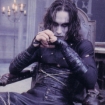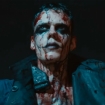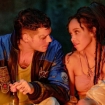Like prom dresses and middle-school diaries, soundtrack albums are potent, often awkward reminders of a particular time and place — cultural artifacts that stir myriad memories for those who lived through the era but impossible to understand if you didn't. The early Nineties were filled with best-selling soundtracks, everything from Dazed and Confused to Pulp Fiction, each of them catering to a specific slice of the listening public. For some fans, the period's preeminent soundtrack belonged to 1994's The Crow; like the movie that inspired it, the collection drips with a moody, eyeliner-smeared darkness that's so of its time, it makes listening to it today comparable to leafing through old graduation photos.
Perhaps more significantly, though, it also represents a critical moment in which hard rock was severely fracturing into two different camps. One of them was grunge, which was best encapsulated in another monster soundtrack of the time, 1992's Singles. As for The Crow, that's where all the misfit toys, moody weirdos and defiant outcasts who didn't fit on the grunge bandwagon went to play. Listening to The Crow now is to be reminded that Nineties rock was more than "the Seattle sound" — and that while the subgenres contained on this record might not have been as huge, they sure added some slinky, grubby vitality to the decade's musical landscape.
It's important to create some context to understand just how much of an anti-Singles the Crow soundtrack was. The Singles movie came out in the fall of 1992, written and directed by Say Anything filmmaker Cameron Crowe, who wanted to make a wistful, episodic look at the love lives of a bunch of sensitive Seattleites. Before its release, though, viewers got the mistaken impression that it was also an insider's peek at the burgeoning grunge scene, which was becoming huge thanks to Soundgarden, Pearl Jam, Alice in Chains and, of course, Nirvana. And although Crowe gave cameos to a few Pearl Jam members, Singles the movie was less about grunge than Singles the album, which featured all those bands except for Nirvana. Non-grunge and/or non-Seattle acts were also part of the soundtrack (including Smashing Pumpkins and Paul Westerberg) but because of Nevermind's commercial and critical breakthrough, the Singles album was able to ride that wave, giving everyone on the record a patina of zeitgeist-y hipness.
By comparison to Crowe's sweet, superficial love story, The Crow was a gritty, R-rated comic-book movie at a time when superhero films weren't flooding the multiplex. Its plot — about a slain rock star, played by Brandon Lee, who comes back to life to seek vengeance — had an extra layer of darkness due to Lee's accidental death just days before the completion of production. (The son of Bruce Lee, Brandon was killed by a defective dummy bullet during filming.) The Crow opened in May 1994, receiving good reviews for Lee, whose tragic death made the story's themes of grief and regret even more poignant in a movie that was otherwise a grimly funny, goth-tinged action flick.
If the Singles soundtrack became the must-have for discerning rock fans, then the soundtrack to The Crow was always seen as a less prestigious record — a hodgepodge of various bands who, with a few exceptions, weren't nearly as fashionable. (However, it's worth pointing out that The Crow went triple-platinum, while Singles merely went double-platinum.) From the perspective of 2019, it's even clearer that The Crow was where some of rock's gnarliest, angriest off-the-beaten-path bands gathered to stew in their own filth and bile. But if Singles was filled with bands who became part of the cultural canon, The Crow housed a lot of artists whose music you secretly loved for its melodramatic, doomed grandeur.
This isn't to say that The Crow doesn't have some huge names on the track list. The album opens with the Cure's "Burn," a tense, dreamy tune highlighted by pained vocals from Robert Smith, whose penchant for makeup, black clothes and poofed-up hair was mirrored in the look of Eric Draven, the dead musician in James O'Barr's original Crow comic. The source material's goth-rock undertones were preserved for the film, and not surprisingly the soundtrack was packed with guyliner-friendly acts like the Jesus and Mary Chain, who contributed the drone-heavy "Snakedriver."
But the record also connected the dots between the post-punk sounds of the Eighties and the industrial-metal bands that came in their wake. The Crow's passing of the baton was most profoundly felt with Nine Inch Nails' snarling cover of Joy Division's "Dead Souls." Trent Reznor was one of the Nineties' biggest acts, but his preference for kinky sex-and-death electronic rock separated him from grunge's comparatively chaste classic-rock sound. On The Crow soundtrack, his aesthetic rules: Everyone from Machines of Loving Grace to My Life With the Thrill Kill Kult get off on industrial's nerve-shredding, hedonistic despair.
Even the album's odd inclusions have their own perverted logic. Punk graybeards Violent Femmes and Rollins Band sit side-by-side with thrashy hardcore courtesy of Pantera. (Several of The Crow's contributors provided covers, including Rollins Band grinding through Suicide's "Ghost Rider" and Pantera paying tribute to forgotten Oregon punk rockers Poison Idea.) Alongside the veterans emerged a feisty new rap-rock unit called Rage Against the Machine, who on the strength of 1992's smash self-titled debut were bringing political consciousness (not to mention hip-hop) to mainstream rock. Their reworking of a "Killing in the Name" B-side, "Darkness," was relatively sedate by their volcanic standards, even though Tom Morello's guitar still screeches on occasion and vocalist Zack de la Rocha sounds off on the West's exploitation of African culture and its moral blindness in ignoring the continent's AIDS epidemic.
But it was The Crow's big radio hit that was indicative of the album's lack of supposed cool. Where Singles featured grunge heavyweights, this album had Stone Temple Pilots, the band everyone at the time slagged as being Pearl Jam rip-offs, all the way down to late singer Scott Weiland's Eddie Vedderesque groans.
STP contributed "Big Empty," their perfectly executed soft-verse/loud-chorus Purple banger that might as well have been called "How to Get a Song on Alternative Rock Radio in 1994." Initially, Stone Temple Pilots were going to go with "Only Dying," a leftover from the band's Core sessions, but reportedly changed their mind out of respect for Lee's accidental death. (However, years later, band member Dean DeLeo admitted that they balked on "Only Dying" partly because it wasn't good enough: "I don't know what I was thinking. Maybe I was listening to too much Robert Smith or something. It's a song where I don't think we reached our full potential as songwriters quite yet.") Regardless, no matter how formulaic "Big Empty" is, it's such a perfect time capsule of its era — big guitars, big emotions, big hooks — that The Crow wouldn't be complete without it.
The industrial/hard-rock/metal sheen of The Crow feels practically primitive to modern ears — a throwback to a time before hip-hop and pop dominated the mainstream. (Even the album's super-pretty ballad, Jane Siberry's weepy "It Can't Rain All the Time," sounds like the sort of closing-credits ditty Bryan Adams or Diane Warren would come up with at the time.) There's definitely a strong remember-when vibe to The Crow, especially when Helmet swagger through their groovy, combustive rocker "Milktoast." There was a time when the New York quartet were pegged to be the next Nirvana — which, spoiler alert, didn't happen — and "Milktoast" both illustrates why Helmet were so amazing and also why their angular, corrosive music would never capture the popular imagination like a Nevermind did. It was too weird, too genuinely angry to ever move the masses.
Like most soundtrack albums that are more than 20 years old, The Crow has its awkward, faddish moments. (The album has more industrial on it than the Billboard Rock Charts have in the last decade.) But its fiercely pugnacious attitude stubbornly remains. For years now, Hollywood has discussed rebooting the Brandon Lee film, with stars like Bradley Cooper and Ryan Gosling unsuccessfully courted to play Eric Draven. Those plans have collapsed again and again, only helping to bolster the original movie's cult appeal. Similarly, it would be hard to imagine what a new Crow soundtrack would sound like in 2019. The Lee film was a product of a comic book, which was a product of the music that inspired James O'Barr in the first place. They're all bound together — an emblem of their time, if not ours.








